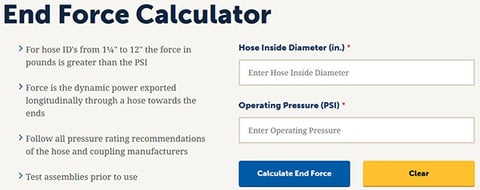At Dixon®, we provide a wide range of interactive tools on our website to help our customers consider the many factors that can impact the best selection and use of our products. One of our most utilized tools is our end force calculator. Keep reading to learn more about this tool and how it's used.
What is End Force?
When a hose is pressurized, there is a force created that would like to "push" the coupling out of the hose. This calculates the force generated as a result of the assembly's working pressure. Mathematically, it is the pressure in the hose multiplied by the area of the inside of the hose.
When Did Dixon Start Using the End Force Calculator?
This calculation has been used for a very long time within the engineering group at Dixon to help optimize our coupling designs. However, the earliest reference found was in a 1982 Dixon Dispatch, an engineering report routinely shared with the Dixon engineering team. The end force is one of many possible loads that could be applied to a hose assembly.
For instance, there could be tension created when a ship drifts away from a barge or a vertically hanging hose needs to be able to support the internal pressure as well as the weight of the hose assembly and the material being conveyed in the hose.
What Kind of Customers Utilize the End Force Calculator?
The maritime industry is an excellent example of the calculator’s use because of the external dynamic forces that should be considered. Additionally, the end force calculator may be useful to the fracking industry because the hoses feeding the drills are large, and the material being conveyed can be very heavy. But anyone concerned about an application that potentially adds external stress to the hose assembly can utilize this tool.
Before selecting a coupling take into consideration all relevant factors that impact performance, including end force.
How Do You Use Dixon's End Force Calculator?

Visit our End Force Calculator tool page to get started. You will be asked to enter the hose inside diameter and operating pressure (PSI) in order to calculate the end force.
Keep in mind, there is no way to test every hose and coupling combination that could exist, but the end force calculator is a great way to estimate what an allowable working pressure may be in a hose assembly given the additional external loads being applied.
Disclaimer: This tool is for reference only. It does not endorse hanging hoses. Hanging hose assemblies should always be supported. Follow all regulations as well as the hose and coupling manufacturer's recommendations.
For example, a 2" hose assembly with a 250 PSI working pressure generates 785 lbs. of end pull force at that pressure. If a 100 lb. weight was hanging from that same assembly, then the maximum end pull force generated by the working pressure must be reduced to 685 lbs. (785 lbs -100 lbs.) to account for that additional load being applied. This allows one to back-calculate the new maximum allowable working pressure of the assembly; in this case, 218 PSI which generates approximately 685 lbs.
If you have any questions regarding your specific application, contact one of our Dixon specialists to discuss your parameters.
Like the End Force Calculator? Check out the rest of our interactive tools!
